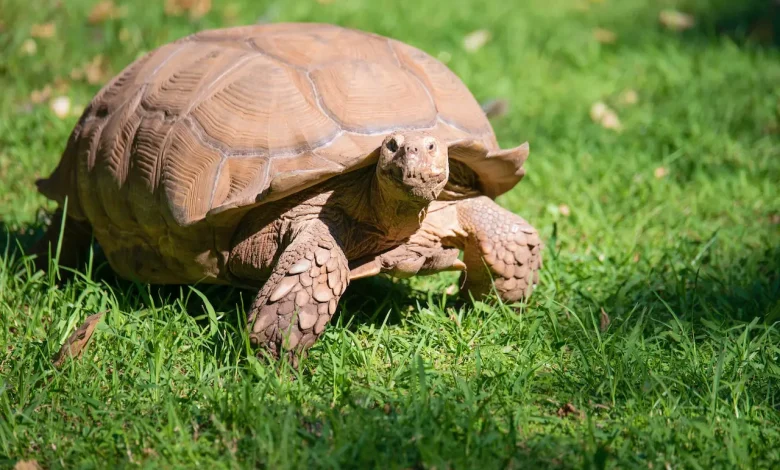Elongated Tortoise – Indotestudo elongata (Endangered)

Elongated Tortoise or Yellow-headed Tortoise.
Thais say: dtow yow (turtle long)
Size: Max 36 cm length. Average adult length of 30.5 cm (12 inches). Adults are about 3.5 kilograms. Males are slightly larger than females.
Appearance: So named because they are longer than wide. The head is light yellow. Shell is yellow with black blotches or has some slight variation in pattern across the species. Some are completely yellow, and others are nearly black. Males are slightly larger than females and have a deep plastral concavity. Females are flatter.
During breeding season the skin around the eyes and nostrils become bright reddish pink. Limbs are brown or dark green.
This genus has front legs which are club-like and with five claws.
Range: Found in Burma, India, Laos, and across Thailand. In Thailand starting in the north, found in provinces: Tak, Loei, Nakhon Ratchasima, Sa Kaeo, Chanthaburi, Chonburi, Uthai Thani, Kanchanaburi, Surat Thani, Krabi, Narathiwat, and Yala.
Habitat: Prefers mixed deciduous forest at some altitude, but also found in monsoonal evergreen forest. Hides among rocks, under fallen trees, or in the root system of large trees. Not found in cold areas.
Active Time: Crepuscular in nature, they prefer dawn and dusk, and other very cloudy days. Their large eyes are suited to foraging in little light.
Food: Herbivorous primarily. Eats grass shoots, leafy greens, flowers, mushrooms, wild onion, terrestrial vines, fruit, snails, slugs, crabs, and dead animals. Seems to prefer mushrooms. Groups can be seen eating where mushrooms flourish after heavy rains.
Offspring: Oviparous. Gravid females lay 2-4 eggs at the end of the rainy season (October, November), which hatch the next rainy season (May).
Eggs are approximately 50 x 40 mm, have a hard shell, and weigh between 42 – 46 grams. Eggs in captivity take only 4-6 months to hatch. In the wild, possibly even 7 months. Hatchlings are 50 – 55 mm long and weigh 30 – 35 grams.
Conservation Status – Endangered species, listed in CITES Appendix II. Illegal harvesting for shells to grind up as aphrodisiacs, to eat (Taiwan and China primarily) and the pet trade are the major threats. Found across a fairly wide distribution.
Recently, however, subsistence has turned into mass harvesting with the value of I. elongata skyrocketing in the Asian food markets (primarily Taiwan and China). This tortoise is the most common one shipped from Vietnam to China for consumption. The price in 2003 for a turtle was $60 USD in China.
Notes: Recently we found the specimen pictured in our garden in Krabi, Thailand in the middle of a residential complex surrounded by walls. Some extensive walking on concrete was required to arrive here.
Classification
Kingdom: Animalia
Phylum: Chordata
Class: Reptilia
Order: Testudines
Family: Testudinidae
Genus: Indotestudo
Species: I. elongata
Binomial name: Indotestudo elongata
Classified by Blyth, in the year 1854.
Resources
Behind the Scenes, A Tortoise Survey of the Shwe Settaw Wildlife Sanctuary, Myanmar. By Dan Sterantino. August 1999.
